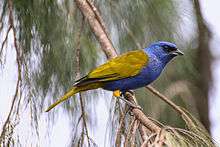Thraupis
Thraupis is a genus of birds of the tanager family occurring from Mexico to Argentina. Some are familiar species with large ranges. As currently defined the genus includes 9 species, but this includes species from two separate clades. Consequently, the genus is paraphyletic and two species (T. cyanocephala and T. bonariensis) are likely to eventually be moved to another genus.[1]
| Thraupis | |
|---|---|
 | |
| Blue-grey tanager | |
| Scientific classification | |
| Kingdom: | Animalia |
| Phylum: | Chordata |
| Class: | Aves |
| Order: | Passeriformes |
| Family: | Thraupidae |
| Genus: | Thraupis F. Boie, 1826 |
| Species | |
|
See text | |
These tanagers are mainly found in semi-open habitats including plantations and open woodland, but some will venture into towns. They feed from medium to high levels in trees, taking mainly fruit, with some nectar, and insects which may be taken in flight. The pair builds a usually well concealed cup nest, but the female incubates alone. The blue-gray and palm tanagers will nest in buildings. Thraupis tanagers have squeaky call notes and songs which consist of 5-10 repetitions of a single or double note.
The genus was introduced by the German naturalist Friedrich Boie in 1826 with the golden-chevroned tanager as the type species.[2][3] The name of the genus is the Ancient Greek word for an unidentified small bird mentioned by Aristotle.[4] As currently defined the genus contains nine species.[5]
Species in taxonomic order
| Image | Scientific name | Common Name | Distribution |
|---|---|---|---|
 | Thraupis episcopus | Blue-grey tanager | Mexico south to northeast Bolivia and northern Brazil, all of the Amazon Basin |
 | Thraupis glaucocolpa | Glaucous tanager | Colombia and Venezuela |
| Thraupis sayaca | Sayaca tanager | Brazil and Bolivia, Paraguay, Uruguay, and northeastern Argentina | |
 | Thraupis cyanoptera | Azure-shouldered tanager | Brazil. |
 | Thraupis ornata | Golden-chevroned tanager | Brazil. |
 | Thraupis cyanocephala | Blue-capped tanager | Bolivia, Colombia, Ecuador, Peru, Trinidad and Tobago, and Venezuela |
 | Thraupis bonariensis | Blue-and-yellow tanager | Argentina, Uruguay, Brazil, Paraguay, Bolivia, extreme northern border Chile, and Andean Peru and Ecuador |
.jpg) | Thraupis abbas | Yellow-winged tanager | Gulf of Mexico and Caribbean coasts from the states of Veracruz and the extreme south of San Luis Potosí in Mexico through the Yucatán Peninsula to Nicaragua, and on the Pacific coast from the Mexican state of Chiapas to Honduras |
.jpg) | Thraupis palmarum | Palm tanager | Nicaragua south to Bolivia, Paraguay and southern Brazil |
References
- Sedano, R. E., & BURNS, K. J. (2010). Are the Northern Andes a species pump for Neotropical birds? Phylogenetics and biogeography of a clade of Neotropical tanagers (Aves: Thraupini). Journal of Biogeography 37: 325–343.
- Boie, Friedrich (1826). "Generalübersicht". Isis von Oken (in German). Col 974.
- Paynter, Raymond A. Jr, ed. (1970). Check-list of Birds of the World. Volume 13. Cambridge, Massachusetts: Museum of Comparative Zoology. p. 318.
- Jobling, J.A. (2018). del Hoyo, J.; Elliott, A.; Sargatal, J.; Christie, D.A.; de Juana, E. (eds.). "Key to Scientific Names in Ornithology". Handbook of the Birds of the World Alive. Lynx Edicions. Retrieved 2 April 2018.
- Gill, Frank; Donsker, David, eds. (2018). "Tanagers and allies". World Bird List Version 8.1. International Ornithologists' Union. Retrieved 2 April 2018.
- ffrench, Richard (1991). A Guide to the Birds of Trinidad and Tobago (2nd ed.). Comstock Publishing. ISBN 0-8014-9792-2..
- Hilty, Steven L (2003). Birds of Venezuela. London: Christopher Helm. ISBN 0-7136-6418-5..
- Morton, Isler & Isler, Tanagers ISBN 0-7136-5116-4.
- Stiles and Skutch, A guide to the birds of Costa Rica ISBN 0-8014-9600-4.
External links
| Wikimedia Commons has media related to |